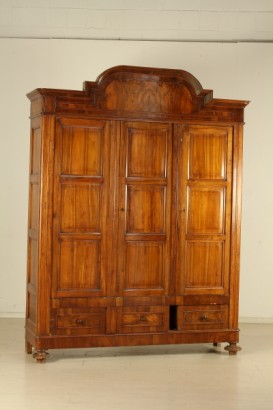Umbertino Wardrobe
Features
Style: Umbertino (1870-1900)
Main essence: Walnut
Material: Solid Walnut
Description
Wardrobe, three front doors and three drawers, coping with briarwood reserve move, the doors are constructed with three panels each frame, interni in poplar. Missing divider between drawers.
Product Condition:
Requires small restoration and resumption of polishing.
Dimensions (cm):
Height: 238
Width: 185
Depth: 57
Certificate issued by: Dott. Cuoccio Vittorio
Additional Information
Style: Umbertino (1870-1900)
The name of this style is due to the ruler of the time Umberto I, appointed King of the Kingdom of Italy on 9 January 1878 and assassinated on 9 July 1900.The Umbertino style is typically Italian and belongs to that Eclectic period that characterized the second half of the 19th century, which lasted just under twenty years, the Umbertino style spread around 1880 and ended around 1895 when a new style called Liberty and universally known took over. like Art-Nouveau to be followed by Art-Decò.
In this style, mainly eclectic and monumental, Gothic and Baroque elements originally belonging to the Renaissance but also adorned with large masks, frames and decorations were re-proposed in the furniture, from the bedside table to the large wardrobe or sideboard.
Find out more about the Umbertine style with our insights:
An Umbertine secretary dedicated to Dante Alighieri
A comparison between a Luigi Filippo console and an Umbertina one






























